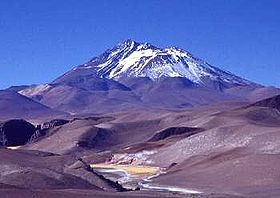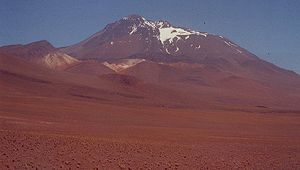- Llullaillaco
-
Llullaillaco 
Llullaillaco in 2006Elevation 6,739 m (22,110 ft) Prominence 2,344 m (7,690 ft) [1] Listing Ultra Location Location  Chile and
Chile and  Argentina
ArgentinaRange Andes, Puna de Atacama Coordinates 24°43′12″S 68°32′13″W / 24.719863°S 68.536852°WCoordinates: 24°43′12″S 68°32′13″W / 24.719863°S 68.536852°W Geology Type Stratovolcano Age of rock Pleistocene Last eruption 1877 Llullaillaco is a stratovolcano at the border of Argentina (Salta Province) and Chile. It lies in the Puna de Atacama, a region of very high volcanic peaks on a high plateau within the Atacama Desert, one of the driest places in the world. It is the fifth highest volcano in the world, and it is also the seventh highest mountain of the Western Hemisphere.[2]
Llullaillaco follows the typical Puna de Atacama volcano pattern: it is surrounded by large debris fields, and is perpetually capped by snow and small glaciers despite the extremely dry conditions of the region.
The peak's name comes from Aymara "murky water": llulla= dirty and yacu= water. Other sources propose it to have originated from Quechua Lullac= lie, Yacu= water: "lying (or treacherous) water".
It has been confirmed that Incas climbed Llullaillaco in the pre-Columbian period. Artifacts on the summit constitute the highest evidence of human presence worldwide before the late nineteenth century. Also, the huáqueros may have also reached its summit and those of other mountains in the region during their searches. The first recorded ascent was on December 1, 1952, by Bión González and Juan Harseim.
Contents
Climbing routes
There are several climbing routes which do not require specialized climbing techniques, although the altitude imposes great difficulty and is by itself a very dangerous factor. Crampons and an ice axe are needed as most paths cross ice fields.
However, the area on the Chilean side of the mountain is known to have some land mines that were installed during the Argentina-Chile conflict period of 1978–1982,[citation needed] thus rendering it extremely dangerous.
Archaeology
During 1983–85 American archaeologist Dr Johan Reinhard directed three surveys of archaeological sites on the summit and slopes of the mountain.
In 1999 on Llullaillaco's summit, an Argentine-Peruvian expedition co-directed by Johan Reinhard and Argentine archaeologist Constanza Ceruti found the perfectly preserved bodies of three Inca children, sacrificed approximately 500 years earlier.[3] This is the highest Inca burial so far discovered in Tawantinsuyu, and is the world's highest archaeological site.[citation needed]
According to contemporary writings by Spanish priests, these children were participants in capacocha, a sacrificial rite that occurred in celebration of key events in the life of the Inca emperor.
The mummies are those of a 15-year-old girl, nicknamed "La doncella" (The maiden), a seven-year-old boy, and a six-year-old girl, nicknamed "La niña del rayo" (The lightning girl). The latter's nickname reflects the fact that sometime in the 500 year period the mummy spent on the summit, it was struck by lightning, partially burning the preserved body and some of the ceremonial artifacts left with the mummies.
The three mummies are exhibited at the Museo de Arqueología de Alta Montaña in Salta, Argentina, in a rotating fashion, so as not to expose any of the mummies for too long a time at once. Mummies are typically rotated in the exhibit every six months.[4]
'La Doncella', older girl mummy
This mummy was found wearing a magnificent headdress, which meant she was probably an aclla or Sun Virgin. That is, she was chosen and sanctified as a toddler to live with other girls and women who would become royal wives, priestesses, and sacrifices. She also wore a brown dress, and was buried with several statues. Her hair was braided elaborately and she had a few white hairs, perhaps indicating emotional stress. She and the others are believed to have been drugged with chicha, a maize beer, along with coca leaves, before being abandoned on the mountain.[5]
Boy mummy
Some of the boy's clothes contained vomit mixed with blood, suggesting that he may have suffered from a pulmonary edema. It is believed that he died from suffocation. He was the only one of the mummies to be tied up, and a piece of cloth had been pulled around him tightly enough to crack his ribs and dislocate his pelvis.[6]
'Lightning Girl', young girl mummy
This child's body was hit by lightning sometime after her death. She wore a headdress with a metal plate over her brow. She was buried with jars which were made around Lake Titicaca and Cuzco, showing how far she may have traveled. She is the only one of the three whose face is turned upward.
Geology
Two major geological stages can be highlighted in the history of the volcano: Llullaillaco I, the ancestral primary volcano, dates back to the Pleistocene. Two very eroded cones with associated lava flows, up to 20 km in length, distributed mainly to the West, evidence these stages.
Built upon it there is a well preserved secondary post-glacial edifice called Llullaillaco II, which has been active during human history. Many Holocene lava flows are associated with this latter phase; the two most notable are directed North and South of the volcano. These youthful-looking dacitic flows have been dated to be of late Pleistocene age. Moreover, hot avalanche deposits, extending up to 3 km, are associated with one of the southern lava flows. There are still other very conspicuous flows remaining: one of the most striking, apparently caused by partial collapse of Lullaillaco I about 150,000 years ago, extends eastward into Argentina, diverging around Cerro Rosado stratovolcano 17 km to the East and terminating in the Salar del Llullaillaco. This deposit has not yet been thoroughly studied.
There are reports of eruptions in 1854, 1868, and 1877, possibly causing the youngest lava flows in the area, which are easily recognizable because of their very dark appearance.
See also
References
- ^ "Cerro Llullaillaco, Argentina/Chile". Peakbagger.com. http://www.peakbagger.com/peak.aspx?pid=8545.
- ^ Andes 6000m peak list
- ^ Secretaría de Cultura de Salta Argentina – MISSION AND ORIGINS. Maam.culturasalta.gov.ar (2007-12-16). Retrieved on 2010-12-14.
- ^ Grady, Denise (September 11, 2007). "In Argentina, a Museum Unveils a Long-Frozen Maiden". The New York Times. http://www.nytimes.com/2007/09/11/science/11mummu.html. Retrieved 2007-09-11.
- ^ Secretaría de Cultura de Salta Argentina – ORIGEN Y MISION. Maam.org.ar (2007-12-16). Retrieved on 2010-12-14.
- ^ Child mummies yield 'grim' evidence. Metro.co.uk (2007-10-02). Retrieved on 2010-12-14.
- Siebert L, Simkin T (2002-). Volcanoes of the World: an Illustrated Catalog of Holocene Volcanoes and their Eruptions. Smithsonian Institution, Global Volcanism Program Digital Information Series, GVP-3, (http://www.volcano.si.edu/world/).
- Reinhard, Johan: The Ice Maiden: Inca Mummies, Mountain Gods, and Sacred Sites in the Andes. National Geographic Society, Washington, D.C., 2005.
- Reinhard, Johan and Ceruti, María Constanza: "Inca Rituals and Sacred Mountains: A Study of the World's Highest Archaeological Sites" Los Angeles: UCLA, 2010.
- Reinhard, Johan and Ceruti, María Constanza: Investigaciones arqueológicas en el Volcán Llullaillaco: Complejo ceremonial incaico de alta montaña. Salta: EUCASA, 2000.
- Reinhard, Johan and Ceruti, María Constanza: "Sacred Mountains, Ceremonial Sites and Human Sacrifice Among the Incas." Archaeoastronomy 19: 1–43, 2006.
- Ceruti, María Constanza: Llullaillaco: Sacrificios y Ofrendas en un Santuario Inca de Alta Montaña. Salta: EUCASA, 2003.
- Reinhard, Johan: "Llullaillaco: An Investigation of the World's Highest Archaeological Site." Latin American Indian Literatures Journal 9(1): 31–54, 1993.
- Beorchia, Antonio: "El cementerio indígena del volcán Llullaillaco." Revista del Centro de Investigaciones Arqueológicas de Alta Montaña 2: 36–42, 1975, San Juan.
- Previgliano, Carlos, Constanza Ceruti, Johan Reinhard, Facundo Arias, and Josefina Gonzalez: "Radiologic Evaluation of the Llullaillaco Mummies." American Journal of Roentgenology 181: 1473–1479, 2003.
- Wilson, Andrew, Timothy Taylor, Constanza Ceruti, Johan Reinhard, José Antonio Chávez, Vaughan Grimes, Wolfram-Meier-Augenstein, Larry Cartmell, Ben Stern, Michael Richards, Michael Worobey, Ian Barnes, and Thomas Gilbert: "Stable isotope and DNA evidence for ritual sequences in Inca child sacrifice." Proceedings of the National Academy of Sciences 104 (42): 16456-16461, 2007.
External links
- Brief geology and geochemistry descriptions. Includes a satellite photograph
- Expedition to the mountain. Several photographs
- Museum of High Mountain Archaeology (Spanish)
- Catholic University´s Institute of High Altitude Archaeology (Spanish)
- "Llullaillaco". SummitPost.org. http://www.summitpost.org/page/184475.
Andean volcanoes Northern Volcanic Zone (6° N–3° S) Nevado del Ruiz · Nevado del Huila · Galeras · Cayambe · Reventador · Pichincha · Antisana · Illiniza · Cotopaxi · Quilotoa · Tungurahua · SangayCentral Volcanic Zone (15°–27° S) Ampato · Coropuna · Sabancaya · Chachani · El Misti · Ubinas · Huaynaputina · Parinacota · Irruputuncu · Azufre · Sairecabur · Pacana · Licancabur · Lascar · Llullaillaco · Galán · San Francisco · Ojos del SaladoSouthern Volcanic Zone (33°–46° S) Tupungato · Tupungatito · Maipo · Calabozos · Descabezado Grande · Cerro Azul · Nevado de Longaví · Nevados de Chillán · Antuco · Copahue · Callaqui · Lonquimay · Llaima · Sollipulli · Villarrica · Quetrupillán · Lanín · Mocho-Choshuenco · Carrán-Los Venados · Puyehue-Cordón Caulle · Osorno · Calbuco · Hornopirén · Michinmahuida · Chaitén · Corcovado · Cay · Macá · HudsonAustral Volcanic Zone (49°–55° S) Note: volcanoes are ordered by latitude from north to southCategories:- Volcanoes of Antofagasta Region
- Geography of Salta Province
- Stratovolcanoes of Chile
- Subduction volcanoes
- Mountains of Argentina
- Volcanoes of Argentina
- Salta Province
- Mountains of Chile
- Polygenetic volcanoes
- Argentina–Chile border
- International mountains of South America
- Human remains (archaeological)
Wikimedia Foundation. 2010.


